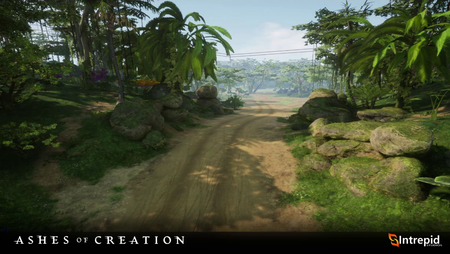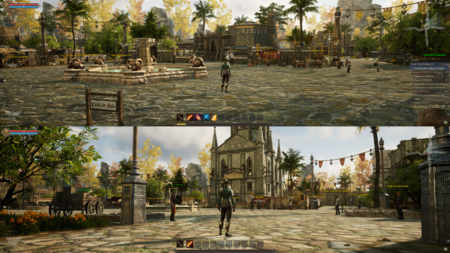Procedural generation
Ashes of Creation will predominantly have curated content, but procedural mechanics will be leveraged in a places where they don't appear to be 'procedural'.[1]
- Verra's map will not be procedurally generated, but starting resource points may be different on each server.[2][3]
- Node locations and types are predefined and are the same on each server but they will develop differently on each and drive different narratives and storylines.[4][3][5]
- 節點佈局與風格 is determined by several factors, such as Environment (biome) and location, Node type, and Race.[6][7]
- 维拉 are both pre-generated and player influenced.[1][8]
Wherever we can leverage procedural mechanics in such a way that does not appear procedural we should. There's a healthy blend between the things that we do in having defined parameters for it and then incorporating a procedural component; and in that sense it will be perceived well, but where we the predominance of what we're implementing should be curated or by design.[1] – Steven Sharif
维拉

我们在游戏中的道路系统基本上是由预先设置的路线驱动的,这些路线通向曾经是维拉古代公路系统的大动脉;从那里开始,当节点前进时,有一些道路会显现出来;我们称这些为静脉。它们来自于主干道,然后随着节点的推进,有一些兴趣点,正如杰夫之前讨论的那样。这些存在于世界各地的兴趣点,其中一些与多个节点共享覆盖范围,但取决于哪个节点推进到激活兴趣点的阶段,它将创建这些小路,可以说,然后从节点本身出发。因此,你从大动脉古道--那种贯穿不同区域的古道--分解成通向特定营地和村镇的静脉,然后从独立的小路中衍生出来,通向这些地区的兴趣点。 到这些地区的兴趣点,是狩猎场。这些都是最初没有显现的,随着玩家们在世界范围内的推进,它们也会上线。.[8] – Steven Sharif
- 最大的道路被称为动脉。这些都是曾经的维拉古代公路系统的遗迹。[8]。
- 随着节点推进较小的道路,被称为静脉,连接动脉和节点。[8]
- 根据节点推进的阶段,小路会从节点上干出,连接到兴趣点.[8]。
- 道路或小路不会因为在同一地区的反复交通而被磨损成普通的地面。[8]。
不同的季节和事件可能会影响到各种道路的通行。[11][12][13]。
- 夏季开放的路径在冬季可能会关闭。[13]。
- 季节性影响可能会对通过大篷车运输货物造成障碍或堵塞。[11][12][14]
- 水在冬天会变成冰,使玩家能够在水面上行走,但却阻挡了玩家进入水面下的东西。[13]
- 冰会使道路颠簸和湿滑。[15]
地下世界 路线 将动态地打开或关闭 (基于节点状态).[16]
節點佈局與風格

The layout and architecture within a Node’s development area are determined by influential race. For example, a stage 3 Node with the majority of player contribution being Py'rai would have a Py'rai village with Py'rai architecture. Most NPCs would be Py'rai elves, and offer questlines within the Py'rai narrative.[4] – Margaret Krohn
Each player’s contributed experience is flagged with their character race and other identifiers. When a Node advances, the race with the highest experience contribution determines the Node’s style and culture. This style and culture change can happen at every Node Stage. For example, if a Node advances to Level 2 - Encampment Stage and 51% of all experience was earned by Ren’Kai players, the Node will be a Level 2 Ren’Kai Node. If that same Node advances to a Level 3 - Village Stage Node, but the Py'Rai contributed 62% of all the experience earned, then the Node will be a Level 3 Py'Rai Node.[18] – Margaret Krohn
節點佈局與風格 is determined by several factors:[6][7]
- The way that the node system is built is that they can exist across a spread of 18 biomes, but at the same time have to represent the cultural influence of these cultures that are intrinsically a part of a specific biome.[19] – Steven Sharif
- Environment (biome) and location of the node.[19][6][7]
- Nodes will adjust the local topography to fit the aesthetic and mechanical requirements of the node.[20]
- Currently the way that the platform system is set up, is it's capable of adjusting the topography of the node's footprint, regardless of the surrounding terrain. So the reason for that is we want to have flexibility in the presentation of the node's layout and how it is essentially both from an aesthetic standpoint as well as a mechanical standpoint with node sieges- how it's constructed and that construction should have the ability to take on a variance of different types of topography. So it shouldn't be dependent on the surrounding area. Now that's not to say that the surrounding area isn't going to have some influence over. So for example... we're experimenting a little bit with the platform tech and putting up a node up against the side of a mountain or on the edge of a cliff or something that has a beautiful vista. Those are things that we're going to test out obviously as we continue to work on the node tool and how that platform system works, but the idea is to have the node independent of the surrounding terrain.[20] – Steven Sharif
- Some parts are determined by the area it's in. Some parts are determined by the type it is. Some parts are determined by the race it is; and then the rest of it is determined by the mayor.[7] – Jeffrey Bard
- Race that contributed the highest percentage to the node's advancement will alter the racial appearance of its buildings, NPCs, and props.[21][22][6][18][7][23][24]
- All nodes, whether they're associated with a castle or associated with normal node structure, has cultural influences that replicate over to the buildings that are produced and the NPCs that are present.[25] – Steven Sharif
- The rest is determined by the node's mayor.[7]
- It should be possible for a node to complete several building projects within a mayor's one month term in office.[26]
- Q: How long would you say it will take players on average to fill/build up a node completely from wilderness to metropolis?
- A: It's one thing to get a node to a certain level: it's another thing to develop the node; and I can't really give you an on-average expectation, because there's a lot of variables at play. There's how many citizens does the node have attracted to it; what's the type of traffic that the node is attracting to it based on things like its tax rates, or the specialization that it chose to spec into, based on the building types it's chosen to build. All of those things are variables that can affect the quote-unquote "average build-out time" of a particular node. So it's difficult to give you an average when there's so many variables along those lines. But the idea is that if there is a particular project that players are interested in in developing based on the node stage, that they would have the ability to complete several of those projects as within a single term of a mayor; and a term of a mayor is one month.[26] – Steven Sharif
世界管理員
The 世界管理員 is an algorithm in Ashes of Creation that controls dynamic world elements. It acts as both a throttle and an incentive system for various activities to ensure certain parameters are within acceptable thresholds.[27]
- A world manager is a technical term to define a server process that lives alongside the game server; and when the game server needs to do things- communicating with other game servers within that grid- it tells that manager and that manager sends it down to the appropriate server.[28] – Steven Sharif
- Prices of glint.[29]
- A heatmap of experience being gained to apply to node advancement.[29]
- The territory expansion algorithm takes into account the nearest coast, neighboring nodes, and the heatmap of players in surrounding areas over the last weeks or month.[30]
- Due to the way the progression algorithm calculates territorial (ZOI) expansion during node advancement, there is a small possibility that two nodes of the same stage end up being close to each other.[31]
- Transit of resources and goods between regions to drive quest rewards for nodes.[29]
- For example if you know iron is being used as a raw resource for a specific crafting path that might drive up the price of mithril or silver; and that will incentivize the market to course correct a little bit. The idea is to provide soft incentives that help to alleviate the demand and also to prop up the supply that might not be present from the economic systems.[29] – Steven Sharif
其他
引用
- ↑ 1.0 1.1 1.2 直播, 2022-02-25 (1:07:36).
- ↑

- ↑ 3.0 3.1 直播, 2017-05-19 (37:03).
- ↑ 4.0 4.1 Blog - Know Your Nodes - The Basics.
- ↑ A reactive world - Nodes.
- ↑ 6.0 6.1 6.2 6.3 直播, 2020-10-30 (39:17).
- ↑ 7.0 7.1 7.2 7.3 7.4 7.5 7.6 直播, 2018-09-27 (53:06).
- ↑ 8.0 8.1 8.2 8.3 8.4 8.5 8.6 直播, 2021-01-29 (1:13:04).
- ↑ 直播, 2021-01-29 (55:44).
- ↑ 直播, 2018-02-09 (45:48).
- ↑ 11.0 11.1 11.2 11.3 Podcast, 2021-04-11 (23:36).
- ↑ 12.0 12.1 直播, 2020-06-26 (1:29:06).
- ↑ 13.0 13.1 13.2 13.3 直播, 2017-05-08 (20:27).
- ↑ Our immersive world - Environments.
- ↑

- ↑ 直播, 2020-10-30 (1:19:13).
- ↑ 直播, 2017-05-19 (32:23).
- ↑ 18.0 18.1 18.2 Blog - Know Your Nodes - Advance and Destroy.
- ↑ 19.0 19.1 直播, 2022-02-25 (41:00).
- ↑ 20.0 20.1 直播, 2021-02-26 (1:12:18).
- ↑ 直播, 2022-03-31 (4:57).
- ↑ Podcast, 2021-04-11 (29:47).
- ↑ 訪談, 2018-05-11 (54:34).
- ↑ 直播, 2017-05-26 (21:23).
- ↑ 25.0 25.1 訪談, 2018-05-11 (47:27).
- ↑ 26.0 26.1 直播, 2022-07-29 (1:13:09).
- ↑ 訪談, 2020-07-19 (1:10:55).
- ↑ 直播, 2022-10-14 (57:22).
- ↑ 29.0 29.1 29.2 29.3 訪談, 2020-07-19 (1:08:22).
- ↑ 訪談, 2020-07-18 (10:04).
- ↑ 訪談, 2020-07-08 (1:00:15).